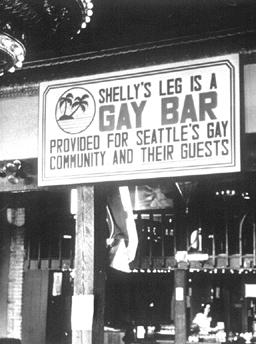Difference between revisions of "1970s - Pioneer Square"
The NWLGHMP (talk | contribs) |
The NWLGHMP (talk | contribs) |
||
| Line 9: | Line 9: | ||
Perhaps the first truly visible “out” space in the city was [[Shelly’s Leg]]. Seattle's first disco, Shelly's Leg, opened in 1973 "at the foot of main" in Pioneer Square. Though frequented by both gays and straights, a prominently displayed sign declared that Shelly's Leg was gay territory. Shelly's Leg exemplifies a shift in attitude in the gay and lesbian community, which was no longer content to meet only in discreet bars and hidden after-hours clubs. | Perhaps the first truly visible “out” space in the city was [[Shelly’s Leg]]. Seattle's first disco, Shelly's Leg, opened in 1973 "at the foot of main" in Pioneer Square. Though frequented by both gays and straights, a prominently displayed sign declared that Shelly's Leg was gay territory. Shelly's Leg exemplifies a shift in attitude in the gay and lesbian community, which was no longer content to meet only in discreet bars and hidden after-hours clubs. | ||
| − | [[Image:shellysign.jpg]] | + | [[Image:shellysign.jpg|center]] |
| − | Sign inside Shelly's Leg Tavern | + | :::::::::Sign inside Shelly's Leg Tavern |
Revision as of 07:43, 1 April 2010
1970s - Pioneer Square
In the 1940s, 50s and 60s, gay and lesbian Seattle was more or less underground. While places like the Garden of Allah may have been known to some straight people, the lesbian and gay community was for the most part very discreet. While the simple act of patronizing a drag bar, or wearing butch clothes might have been a political act, few gay spaces explicitly announced themselves as such. In the late 1960s and early 1970s, that began to change as the era of gay liberation came into full swing.
One of the first non-bar gay and lesbian spaces in Seattle, the Gay Community Center opened its doors in 1972 at First and Cherry in Pioneer Square. The GCC offered everything from alcohol-free dances and macramé classes to meeting spaces for political organizations such as Gay Community Social Services. The GCC moved to Capitol Hill around 1973, and was destroyed by arson in 1976. Even in this 1970s "liberation" period, claiming a space and labeling it gay was risky.
Gay Community Social Services supported a variety of projects that reflects the growth in a community. Located on the Olympic Peninsula, near Port Angeles, Elwah Farms was a gay version of the “back to the land” movement of the mid 70s. A portion of the land was devoted to a women-only space. Another project of GCSS was the album, Lavender Country.
Perhaps the first truly visible “out” space in the city was Shelly’s Leg. Seattle's first disco, Shelly's Leg, opened in 1973 "at the foot of main" in Pioneer Square. Though frequented by both gays and straights, a prominently displayed sign declared that Shelly's Leg was gay territory. Shelly's Leg exemplifies a shift in attitude in the gay and lesbian community, which was no longer content to meet only in discreet bars and hidden after-hours clubs.
- Sign inside Shelly's Leg Tavern
Established in the bars and liberated by New York City's Stonewall riots in 1969, the lesbian and gay community branched out in the 1970s. Seattle's lesbians and gays commemorated Stonewall with protests and rallies throughout the early '70s. In 1977 Mayor Uhlman declared the first "Gay Pride Week" in Seattle. That year, gays and lesbians marched in the streets of Pioneer Square, demanding recognition and celebrating their visibility. As the focus of Seattle's gay community shifted from Pioneer Square to Capitol Hill, so did the parade.
Over 2000 people gathered in Pioneer Square’s Occidental Park and marched north along First Avenue to Westlake Park. In light of the gains that had been made in the early 70s – repeal of the state sodomy law, a non-discrimination ordinance, and increasing visibility of gay and lesbians – some letters to the Seattle Gay News wondered if there was really a need for a Pride Parade. Less than a year later, though, it became clear that the parade was needed.
In 1978 and 1979 the annual gay pride route was downtown, ending at a rally in Occidental Park. The 1978 rally was especially fervent, ushering in a summer of activism against Initiative 13. The following year, with a successful campaign to its credit, the community was still feeling the spirit of its new political voice.
Many activists carried this energy into other causes. For example, Women Against Thirteen (WAT), morphed into Women Acting Together and applied its organizing strength to other feminist efforts.
Also, during this period women's only bars, like the Silver Slipper emerged. In prior decades, taverns like the Madison may have provided a few nights a week for women but rarely was any place exclusively for women. The changes in experience are recounted in the Women's Bars - Oral Histories.
Seattle, WA: Queen City Comes Out: Exploring Seattle's Lesbian and Gay History
